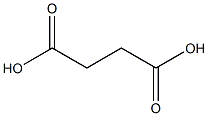
Succinic acid
Melting point | 185 °C |
Boiling point | 235 °C |
Density | 1.19 g/mL at 25 °C(lit.) |
Refractive index | n20/D 1.4002(lit.) |
FEMA | 4719 | SUCCINIC ACID |
Flash point | >230 °F |
Storage conditions | Store at RT. |
Solubility | Soluble in ethanol, ethyl ether, acetone and methanol. Insoluble in toluene, benzene, carbon disulfide, carbon tetrachloride and petroleum ether. |
Acidity coefficient (pKa) | 4.16(at 25℃) |
form | Powder/Solid |
colour | White to off-white |
PH value | 2.7 (10g/l, H2O, 20℃) |
Water solubility | 80 g/L (20 oC) |
Succinic acid use and synthesis
Chemical properties
Colorless crystal, sour. Soluble in water, ethanol and ether. Do not dissolve in chloroform or dichloromethane.
Use
1. Used as a chemical reagent and chromatographic reagent, also used in the preparation of buffer
2. Succinic acid is used in the chemical industry to produce dyes, alkyd resins, glass fiber reinforced plastics, ion exchange resins and pesticides; in the pharmaceutical industry for the synthesis of sedatives, contraceptives and cancers, in addition, It can be used for analytical reagents, food iron fortifiers, flavoring agents, etc. Packing and storage: Industrial grade woven bags lined with plastic bags. The net weight of each bag is 25kg. Fine (woven bag) or specified
3. It is mainly used to prepare derivatives such as succinic anhydride and succinate, and is used as raw materials for coatings, dyes, binders, drugs, etc.
4. Succinic acid is an intermediate of fungicide sclerotium and plant growth regulator butyryl hydrazide.
5. Mainly used for the preparation of pentacyclic compounds such as succinic anhydride. Also used in the preparation of alkyd resins (alkyd resins produced from succinic acid have good flexibility, elasticity and water resistance.), paints, dyes (diphenyl succinate is an intermediate for dyes, and The aminoguanidine reacts to form an anthraquinone dye.), a food flavoring agent (succinic acid can also be used as a food sour agent for seasoning of wine, feed, candy, etc.), photographic materials, and the like. It can be used in the pharmaceutical industry to produce sulfa drugs, vitamin A, vitamin B and other anti-caries agents, pine mites, diuretics and hemostatic drugs. As a chemical reagent, it is used as a standard reagent for basic amounts, a buffer, and a gas chromatographic comparison sample. It can also be used as a raw material for lubricants and surfactants.
6. For the manufacture of medicines, spices, dyes and lacquers
7. Alkali method standards, determination of bismuth, copper, bismuth, antimony, bismuth, antimony and nitrite, separation and determination of iron and aluminum, buffer, organic synthesis, gas chromatography comparison samples.
8. Organic synthesis, preparation of pentacyclic compounds; alkali method standards; determination of bismuth, copper, bismuth, bismuth, antimony, bismuth and nitrite; separation and determination of iron and aluminum; gas chromatography analysis standards?
9. Basic organic chemical raw materials. Mainly used in coatings, dyes, adhesives and pharmaceuticals. The alkyd resin produced from succinic acid has good flexibility, elasticity and water resistance. The diphenyl ester of succinic acid is an intermediate of the dye and reacts with aminoguanidine to form an anthraquinone dye. It can be used in the pharmaceutical industry to produce sulfa drugs, vitamin A, vitamin B and hemostatic drugs. In addition, succinic acid is also widely used in the paper manufacturing and textile industries, and can also be used as a raw material for lubricants, photographic chemicals and surfactants. Succinic acid can also be used as a food sour agent for the seasoning of wine, feed, candy and the like.
production method
In addition to being present in amber, succinic acid is also widely found in tissues of various plants and animals. There are many industrial methods, mainly the following: 1. Oxidation paraffin wax is oxidized to form a mixture of various carboxylic acids, and after separation, butanediol can be obtained. 2. Hydrogenation Maleic anhydride or fumaric acid is hydrogenated under the action of a catalyst to form succinic acid, which is then separated to obtain a finished product. The catalyst is nickel or a noble metal, and the reaction temperature is about 130-140 °C. 3. Acrylic acid carbonylation method Acrylic acid and carbon monoxide generate succinic acid under the action of a catalyst. Not yet industrialized. 4. Electrolytic oxidation method phthalic anhydride and sulfuric acid and water in a ratio of 1:0.5:4, electrolysis in a ceramic electrolytic cell, can obtain succinic acid. 5. Acetylene acetylene with carbon monoxide and water in the presence of a [CO(CO)4] catalyst. The reaction temperature is 80-250 ° C, the pressure is 2.94 - 49.03 MPa, and the reaction can be carried out in an acidic medium to obtain succinic acid.
The preparation method is the catalytic hydrogenation of maleic acid, generally using Raney nickel as a catalyst, or palladium as a catalyst, and succinic acid can be obtained. In addition, industrially, paraffinic hydrogenated products can be separated or liquefied with light oil at 150-180 ° C, 3.92 to 4.41 MPa, in the presence of a cobalt/nickel catalyst, and succinic acid can be obtained by separation.